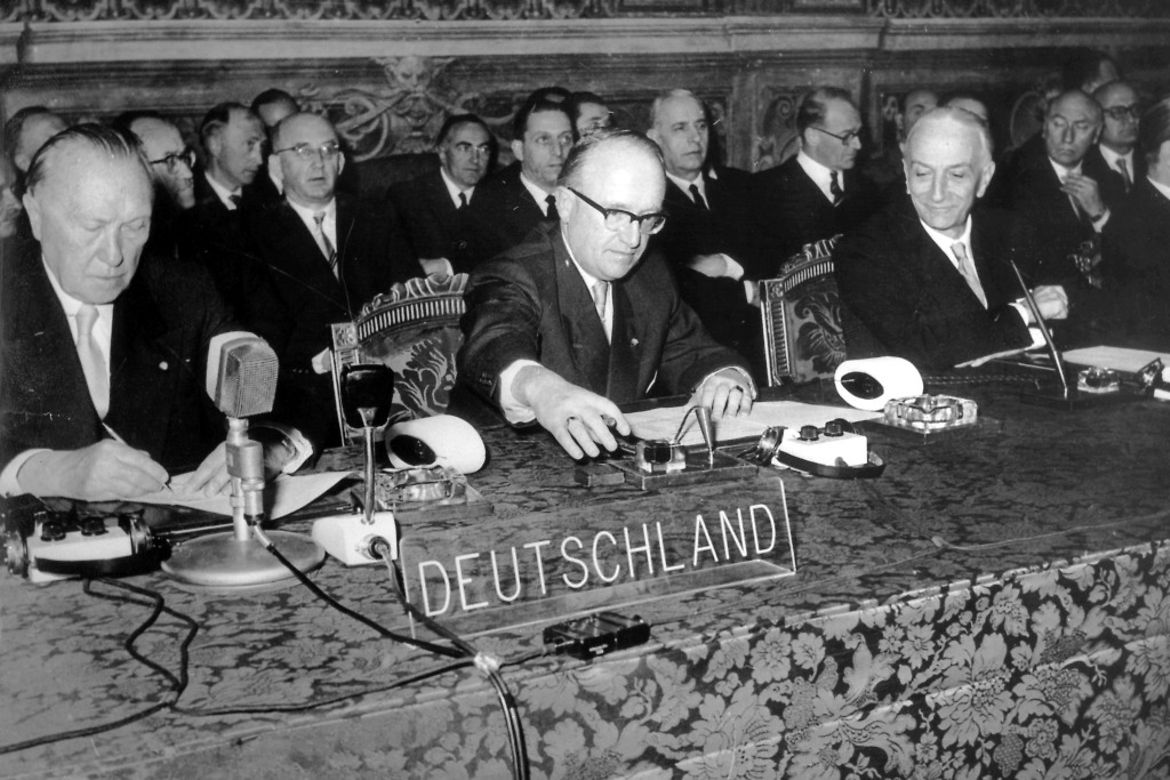
On 25 March 1957 in Rome Chancellor Konrad Adenauer and State Secretary Walter Hallstein signed the founding documents of what became the European Union. Walter Hallstein later became the first EEC Commission President.

On 1 July 1968 the customs union between Germany, France, Italy and the Benelux states came into effect. It abolished customs duties beween member states. The customs union was an important milestone on the way to a European Single Market.

Since 1979, the people of Europe have been able to directly elect the members of the European Parliament. One of them was former German Chancellor Willy Brandt.

In 1985 Germany, France and the Benelux states signed the "Schengen Agreement". They agreed to abolish border controls on persons at their internal borders and to step up controls at their external borders.

Commission President Jacques Delors and Chancellor Helmut Kohl championed the integration of the former East Germany (GDR) into the European community. The reunited Germany is a member of both the European Community and NATO.

On 7 February 1992 the Treaty on European Union was signed in Maastricht. It put in place regulations for the common currency, foreign and security policy, and closer cooperation in the fields of justice and home affairs.

On 1 January 2002 the euro was introduced as an official currency and legal tender. Today 19 EU member states are part of the euro zone.

The European Union continued to grow after the Iron Curtain fell. Ten countries in Central, Eastern and Southern Europe joined the EU, ending the division of Europe. The European Union now has 28 member states.

25 March 2007: The Berlin Declaration on the 50th anniversary of the founding of the EU reaffirmed Europe's commitment to shared values - respect for human dignity, tolerance, solidarity and equal opportunities.

The Lisbon Treaty of 13 December 2007 strengthened the rights of the European Parliament in particular. A common European diplomatic service was also established.

On 25 March 1957 in Rome Chancellor Konrad Adenauer and State Secretary Walter Hallstein signed the founding documents of what became the European Union. Walter Hallstein later became the first EEC Commission President.

On 1 July 1968 the customs union between Germany, France, Italy and the Benelux states came into effect. It abolished customs duties beween member states. The customs union was an important milestone on the way to a European Single Market.

Since 1979, the people of Europe have been able to directly elect the members of the European Parliament. One of them was former German Chancellor Willy Brandt.

In 1985 Germany, France and the Benelux states signed the "Schengen Agreement". They agreed to abolish border controls on persons at their internal borders and to step up controls at their external borders.

Commission President Jacques Delors and Chancellor Helmut Kohl championed the integration of the former East Germany (GDR) into the European community. The reunited Germany is a member of both the European Community and NATO.

On 7 February 1992 the Treaty on European Union was signed in Maastricht. It put in place regulations for the common currency, foreign and security policy, and closer cooperation in the fields of justice and home affairs.

On 1 January 2002 the euro was introduced as an official currency and legal tender. Today 19 EU member states are part of the euro zone.

The European Union continued to grow after the Iron Curtain fell. Ten countries in Central, Eastern and Southern Europe joined the EU, ending the division of Europe. The European Union now has 28 member states.

25 March 2007: The Berlin Declaration on the 50th anniversary of the founding of the EU reaffirmed Europe's commitment to shared values - respect for human dignity, tolerance, solidarity and equal opportunities.

The Lisbon Treaty of 13 December 2007 strengthened the rights of the European Parliament in particular. A common European diplomatic service was also established.